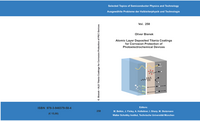
The progressing global warming driven by the continuous emission of greenhouse gases makes a rapid transition to a sustainable world economy essential, resulting in an increasing demand for novel renewable energy technologies. Among these, a promising candidate is solar fuel generation using photoelectrochemical (PEC) cells. Not yet in the market, this emerging approach faces several challenges that must be overcome, including conversion efficiencies, short lifetimes, and the need for large-scale production. In principle, the use of highly efficient light absorber materials as photoelectrodes in combination with corrosion protection layers fabricated by atomic layer deposition (ALD) meets all of these requirements. Nevertheless, several practical challenges remain for the development of such devices. This study aims to elucidate the mechanisms at play in determining the performance characteristics of single-material semiconductor photoelectrodes protected by ALD thin films to improve the solar-to-fuel efficiency of PEC cells. Considering their central importance for solar water splitting, we concentrate on junction energetics and charge transport within the photoelectrode. Within this context, we show how ALD process parameters impact film and junction properties and apply the resulting knowledge to build efficient photoelectrodes. For these investigations, we fabricate photoelectrodes by coating silicon (Si) and indium phosphide (InP) light absorbers with titanium oxide (TiOx) thin films using thermal and plasma-enhanced ALD (PE-ALD), after which we apply suitable catalysts for hydrogen and oxygen evolution. The fundamental properties of the TiOx layers are first characterized using optical, electrical, X-ray, and microscopy techniques, followed by the photoelectrochemical testing of the electrodes. These investigations reveal a broad control of film properties, enabled by thermal and PE-ALD. These include highly tunable defect concentrations and, thus, customized film conductivities, optical properties, and junction energetics with the underlying semiconductor substrate. As a newly developed ALD process type within this work, low-power PE-ALD enables the production of thin films with high optical and electronic quality combined with a significantly enhanced interface quality compared to conventional plasma processes. Minimizing the plasma-induced interfacial oxide by applying low-power instead of regular PE-ALD coatings, PEC performance characteristics of both InP photocathodes and Si photoanodes for water splitting can be significantly improved. Based on our studies, we propose a scheme for creating high-photovoltage photocathodes capable of efficient solar-to-fuel conversion based on precise control of the defect level within the ALD films and the energetic alignment of the photoabsorber bands with the redox levels of the reaction. While sustaining the semiconductor-electrolyte junction in materials with favorable band alignment for water reduction is key for achieving high photovoltages, buried pn heterojunctions between light absorber and degenerately doped TiOx can also be independently generated when the energetic alignment is less favorable. Likewise, photovoltage generation in Si photoanodes coated by TiOx thin films is determined by the junction type between light absorber and protective coating. However, large photovoltages can only be achieved if the defect content of the latter is high enough to enable efficient charge carrier transport through the protection layer. As the findings presented here concern the processes within photoelectrodes, independent of the catalytic surface reaction, they are also transferable to other PEC reactions, such as carbon dioxide (CO2) reduction. On a more general level, the characteristics and benefits of thermal and PE-ALD of metal oxides for engineering semiconductor interfaces revealed by this work can be exploited beyond photoelectrode protection to meet the complex requirements of diverse optoelectronic applications.